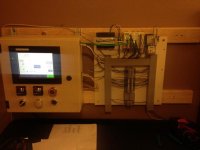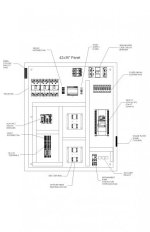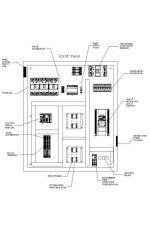Hey everyone.
Within the next two weeks I will (hopefully) have built my first panel.
I had the odd fortune/misfortune (time will tell) of telling my boss about a type of equipment used in our industry that could be quite profitable to us if we could obtain one and refurbish it. Having used/diagnosed/serviced/fixed dozens of examples of poor design, I opened my big mouth that I'm sure there is a better way, and I'm sure that I could figure it out.
So he gave me a budget, enough for components but not enough to hire an integrator, and suddenly I realized how much I don't know...
Now I've written and tested my first PLC program, programmed an HMI interface and can successfully remotely operate my test station. Started my first CAD work and I'll finishing the wiring diagrams soon (before building the real thing). The HMI/temp controller panel is way more cramped than it will be - that was just a first attempt at the cutouts for a trial run before cutting into anything expensive. (Also, the buttons/e-stops are old - just for testing).
Attached are a PDF of the basic panel design and a picture of the test station which is scaled to be the same as the PLC and I/O terminals in the real thing. I don't have wire labels yet (in transit) which I know I need. I plan to label both sides of the terminal blocks. Will also use thin-finger duct - should be neater.
Comments/criticisms welcome. I would prefer that it not LOOK like a first panel, if I can avoid it... And many of you have already helped with advice and pointing me toward helpful articles.


Within the next two weeks I will (hopefully) have built my first panel.
I had the odd fortune/misfortune (time will tell) of telling my boss about a type of equipment used in our industry that could be quite profitable to us if we could obtain one and refurbish it. Having used/diagnosed/serviced/fixed dozens of examples of poor design, I opened my big mouth that I'm sure there is a better way, and I'm sure that I could figure it out.
So he gave me a budget, enough for components but not enough to hire an integrator, and suddenly I realized how much I don't know...
Now I've written and tested my first PLC program, programmed an HMI interface and can successfully remotely operate my test station. Started my first CAD work and I'll finishing the wiring diagrams soon (before building the real thing). The HMI/temp controller panel is way more cramped than it will be - that was just a first attempt at the cutouts for a trial run before cutting into anything expensive. (Also, the buttons/e-stops are old - just for testing).
Attached are a PDF of the basic panel design and a picture of the test station which is scaled to be the same as the PLC and I/O terminals in the real thing. I don't have wire labels yet (in transit) which I know I need. I plan to label both sides of the terminal blocks. Will also use thin-finger duct - should be neater.
Comments/criticisms welcome. I would prefer that it not LOOK like a first panel, if I can avoid it... And many of you have already helped with advice and pointing me toward helpful articles.






